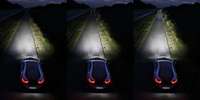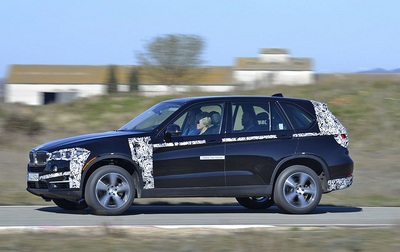2015 BMW X5 PHEV Efficient Dynamics Innovations
By Henny Hemmes
Senior European Editor
The Auto Channel
THE HAGUE, October 26, 2014; Just before the turn of the century, BMW started to implement a special strategy to stay ahead of their competitors. It resulted in the development of technologies to reach three goals: reduction of energy demand, a dynamic power train and intelligent energy management. Since 2007, those technologies and all new measures are bundled under the flag of the Efficient Dynamics strategy. And the results are noticeable: between the mid nineties and 2010, the Group has realized a 25 per cent reduction of CO2 emissions en fuel consumption of its European fleet. In the meantime more than 100 models of the Group’s divisions meet the tight Euro 6 emission standards that will take effect in September.
New production models such as the all-electric i3 mega city car and the i8 plug-in hybrid sports car are an example of BMW’s broader look at future mobility. The Mini E and plug-in hybrid 1 Series were only the test beds for a more flexible line up in the respective models of Mini and BMW. But that also goes for the Hydrogen 7, a limited production hydrogen variant of the 7-Series.
Another plug-in hybrid will be introduced on the market. It is the X5 eDrive, which gets a driveline that is based on the same principle as the i8’s technology. Of course, it will pay off in the big SUV with a reduction of fuel consumption. The driveline is not exactly the same, as the X5 gets a 2.0-liter 4-cylinder variant of the new generation of engines (the i8 has a 1.4-liter 3-cylinder). BMW promised us that the X5 eDrive will reach 74 mpg
In the spring we drove a prototype of the plug-in hybrid X5, to be dubbed X5 eDrive, at BMW’s proving ground in southern France ( Read Article) where several new Efficient Dynamics Innovations were presented.
In the meantime, BMW has announced that the main electric drive technologies and components are developed in-house - and also produced in Dingolfing from next year. "Here, our accumulated know-how gives us an advantage in the competition. This manifests itself not only in the performance of the BMW E-motors and high-voltage battery, but also in a highly efficient mode of production ". said mrs. Ilka Horst Meier, BMW’s head of planning and production drive systems. "In order to represent the expected range of e-drive components, the BMW Group uses an intelligent modular system eDrive.”
Battery modules for the BMW i8 and also for the future built BMW X5 with eDrive technology are assembled on the same production line The new battery production lines are designed for more flexible and highly efficient future models simultaneously When BMW unveiled the X5 eDrive PHEV at the New York Auto Show in April, they said that deliveries will start in the first quarter of 2015. We may expect pricing from around $ 60,000.
Dr. Marcus Bollig, Vice president Efficient Dynamics: “Customers are getting used to important measures such as start-stop and eco Pro mode. A few years ago, we introduced the ‘Foresight’ predictive navigation system and now we are presenting its predictive power train. This one is still in the testing phase, but we can show what it does.”
It is a further development of the technology that shifts the transmission before corners. Invisible help comes from electronics and software controls, GPS navigation, ultrasonic and radar sensors, cameras and environment data. The transmission control of the 8-speed automatic uses all data combined to determine the correct driving strategy. The system scans its surroundings and manages gear selections and engine revolutions to save fuel and help creating more safety.
Proactive Driving Assistant We could get a taste of predictive driving at the helm of a 5 Series prototype with the Proactive Driving Assistant at the proving ground. With 50 mph we approached the slower driving car in front of us. Active Cruise Control would just slow us, but now, based on the same algorithm, the gear of the 8-speed automatic changes to Manual to override automatic and prevent switching down. The engine lifts up revs and reacts more direct to the acceleration.
It also works for an average overtaking maneuver. We are used to turn the signal and push the throttle to go into lower gear. The ‘assistant’ recognizes the intention of such a move and shifts down to the right gear as soon as you signal to pass. This cuts back time and speeds up acceleration at the moment you need it, so that you can mix into the next lane quicker. It works within any speed range, as long as the transmission is able to switch gears. The peed difference is adaptive. For example, if you drive 35 mph and the other car comes up at 40 mph, than there is no gear shift. When you drive 60 mph and the other car 65 mph, there is.
The system also can down change, for instance when approaching a tight corner, so that the right gear is enabling you to move quick. The system helps normal drivers to maneuver safely and also adds to fuel saving. During the few laps we drove, I was fully aware of the fact that the system is active. But I can imagine that you will not notice it anymore during a daily drive. That is, until it does not work anymore.
After riding shotgun recently in an automated driving BMW M235i ( Read Article) it was not difficult to realize that the new driving assistant is part of the technology for driving autonomously.
Light weight optimization
There are also measures that are invisible to the customer, but not
important for energy saving. The Efficient Dynamics engineers work in
different fields and we saw evolutions of technologies that were already
revealed or new (to us).
Instrumental in the quest for decreasing fuel consumption is weight saving.
In this respect, Audi has long ago adapted aluminum. And in 2007, BMW
started using carbon fiber, popular for CFRP (Carbon Fiber Reinforced
Plastic), for the first time for the roof of the M3. The i3 is the first
mass produced vehicle world wide with all body panels made of CFRP. During
the world premier of the i3, last summer, BMW claimed a weight reduction of
550-770 pounds.
Franz Storkenmaier, Head of Lightweight Design said: “We gained experience from the M cars and now we have to find out how to use carbon fiber waste from the Project i models for other production.” Production cut offs can be reprocessed in to so-called secondary (recycled content) CFRP and be used for seat frames, dashboard frames (30 % lighter than magnesium) and spare wheels.
We also saw a CFRP steering wheel prototype with a heart of steel. Mr. Storkenmaier could not say anything yet about the weight saving.
Acoustic light weight design In order to reduce not only weight, but also engine noise, the engineers are also working on acoustic light weight design measures. For example belt drive sound insulation, oil sump encapsulation and engine- en transmission mounted encapsulation. Another advantage is that efficient power train noise reduction measures will also reduce the amount of material used for such measures by some 25 per cent.
CFRP for wheels, propeller shafts and more Years ago, Toyota unveiled a concept car at the Detroit auto show with carbon fiber wheels, but I have not heard about it anymore. At Miramas, BMW showed an 17-inch hybrid aluminum/CFRP wheel rim, that is ready for production. According to Storkenmaier, the weight saving is roughly 25 per cent: “Another 10 percent could be gained with one completely of CFRP (picture).”
When I asked him if what if such a wheel is damaged, he said that this would not have the same impact as with aluminum, since it is easier to repair. Carbon fiber is also already used for the propeller shaft in the M3/M4. Because the material is so strong, the shaft could be produced in one single piece without the center bearing. It results in a weight saving of 6.6 pounds (40 per cent) compared to the previous component and also reduces rotating masses, which translates into improved handling.
 |
On the subject of car lighting, I realized we have come quite a long way, from bulbs to halogen, to xenon and on to LED. Now, the next thing is laser light, which we have already high lighted early this year.( Read Article.) In Miramas we took a ride with Thomas Hausmann, Head of pre-development Light, in a 7 Series prototype for an evening demonstration.
The bright white light illuminates the road and shoulders ahead much further than we are used to: some 0.4 mile, or nearly 2,000 feet. After switching off the laser’s 10 Watts of power, the LED lamps show the difference – and LEDs are not bad at all! Laser light offers a huge safety improvement, as you can also see animals (deer…!) along the road (The picture shows from left to right the LED Low Beam, LED high beam and the LED high beam & Laser booster)
The team of Hausmann is still working on refinements, but has already included a feature that automatically dims the lamps when traffic is approaching and/or in the same area of the lighting race.
BMW aimed to be the first car manufacturer to offer laser light this fall in the i8 PHEV spots car. But Audi drove a way with a victory in this respect, by offering the special-edition R8 LMX on the European market.
Indeed laser light cannot be offered in North America. Not yet, as the NHTSA has no regulations allowing the use of the innovative technology. That’s why Audi and BMW will have to lobby with legislators and convince them that also the American drivers would really benefit from the much improved visibility and consequently improved safety.



